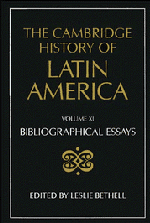Book contents
- Frontmatter
- I THE INDIGENOUS PEOPLES OF MIDDLE AND SOUTH AMERICA ON THE EVE OF THE CONQUEST
- II COLONIAL SPANISH AMERICA
- 1 The Spanish conquest and settlement of America
- 2 Indian societies and the Spanish conquest
- 3 Spain and America in the sixteenth and seventeenth centuries
- 4 Spain and America: The Atlantic trade, 1492–c.1720
- 5 Spain and America in the eighteenth century
- 6 Population
- 7 Urban development
- 8 Mining
- 9 The formation and economic structure of the hacienda in New Spain
- 10 The rural economy and society of Spanish South America
- 11 Aspects of the internal economy: Labour, taxation, distribution and exchange
- 12 Social organization and social change
- 13 Indian societies under Spanish rule
- 14 Africans in Spanish American colonial society
- 15 Women in Spanish American colonial society
- 16 The Catholic church
- 17 Literature and intellectual life
- 18 Architecture and art
- 19 Music
- III COLONIAL BRAZIL
- IV THE INDEPENDENCE OF LATIN AMERICA
- V LATIN AMERICA: ECONOMY, SOCIETY, POLITICS, c. 1820 TO c. 1870
- VI LATIN AMERICA: ECONOMY, SOCIETY, POLITICS, c. 1870 to 1930
- VII LATIN AMERICA: ECONOMY, SOCIETY, POLITICS, 1930 to c. 1990
- VIII IDEAS IN LATIN AMERICA SINCE INDEPENDENCE
- IX LATIN AMERICAN CULTURE SINCE INDEPENDENCE
- X THE INTERNATIONAL RELATIONS OF LATIN AMERICA SINCE INDEPENDENCE
- THE CAMBRIDGE HISTORY OF LATIN AMERICA
4 - Spain and America: The Atlantic trade, 1492–c.1720
from II - COLONIAL SPANISH AMERICA
Published online by Cambridge University Press: 28 March 2008
- Frontmatter
- I THE INDIGENOUS PEOPLES OF MIDDLE AND SOUTH AMERICA ON THE EVE OF THE CONQUEST
- II COLONIAL SPANISH AMERICA
- 1 The Spanish conquest and settlement of America
- 2 Indian societies and the Spanish conquest
- 3 Spain and America in the sixteenth and seventeenth centuries
- 4 Spain and America: The Atlantic trade, 1492–c.1720
- 5 Spain and America in the eighteenth century
- 6 Population
- 7 Urban development
- 8 Mining
- 9 The formation and economic structure of the hacienda in New Spain
- 10 The rural economy and society of Spanish South America
- 11 Aspects of the internal economy: Labour, taxation, distribution and exchange
- 12 Social organization and social change
- 13 Indian societies under Spanish rule
- 14 Africans in Spanish American colonial society
- 15 Women in Spanish American colonial society
- 16 The Catholic church
- 17 Literature and intellectual life
- 18 Architecture and art
- 19 Music
- III COLONIAL BRAZIL
- IV THE INDEPENDENCE OF LATIN AMERICA
- V LATIN AMERICA: ECONOMY, SOCIETY, POLITICS, c. 1820 TO c. 1870
- VI LATIN AMERICA: ECONOMY, SOCIETY, POLITICS, c. 1870 to 1930
- VII LATIN AMERICA: ECONOMY, SOCIETY, POLITICS, 1930 to c. 1990
- VIII IDEAS IN LATIN AMERICA SINCE INDEPENDENCE
- IX LATIN AMERICAN CULTURE SINCE INDEPENDENCE
- X THE INTERNATIONAL RELATIONS OF LATIN AMERICA SINCE INDEPENDENCE
- THE CAMBRIDGE HISTORY OF LATIN AMERICA
Summary
In spite of a great quantity of recent literature the history of Spanish and Spanish American oceanic navigation and trade before 1720 is very uneven in its availability and level of sophistication. Some aspects, eras and episodes are well known; others, such as the connections between certain specific areas and the carrera, have been studied hardly at all. Yet others, such as the dimensions and significance of smuggling, can never be known accurately. The subject has also suffered from a tug-of-war between romance and statistics. Some writers have emphasized treasure, pirates, hurricanes, galleons and derring-do on the Spanish Main. The other school has counted the ships, the crews, the crossings, the prices, the cargoes, until the graphs and tables reduce the whole epic to banality.
The literature on the expansion of Europe is immense and there are many approaches. One of the most imaginative and comprehensive surveys is Pierre Chaunu, L’expansion européenne du XIIIe au XVe siècle (Paris, 1969), a fine example of the author’s emphasis on economics and geography. Another general survey, more closely tied to men and events, is Boies Penrose, Travel and Discovery in the Renaissance, 1420–1620 (Cambridge, Mass., 1952). Carlo Cipolla in his entertaining Guns, Sails and Empires: Technological Innovation and the Early Phases of European Expansion, 1400–1700 (New York, 1966), summarizes what we know about the role of material advantages in Europe’s advance overseas. John H. Parry, Europe and a Wider World, 1415–1715 (London, 1959), explains early routes, ships, navigation and trade.
- Type
- Chapter
- Information
- The Cambridge History of Latin America , pp. 50 - 56Publisher: Cambridge University PressPrint publication year: 1995



